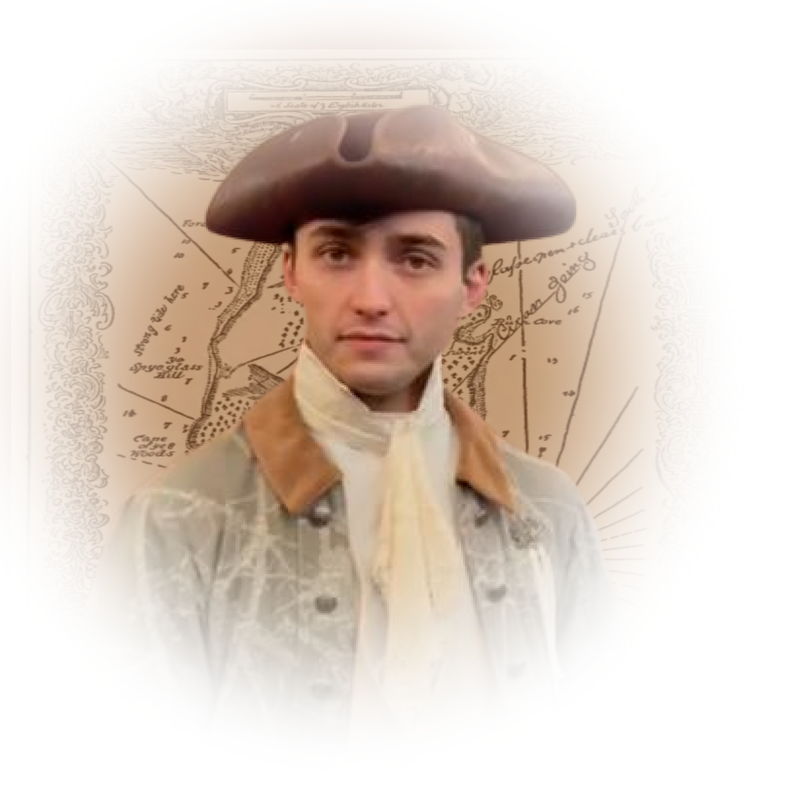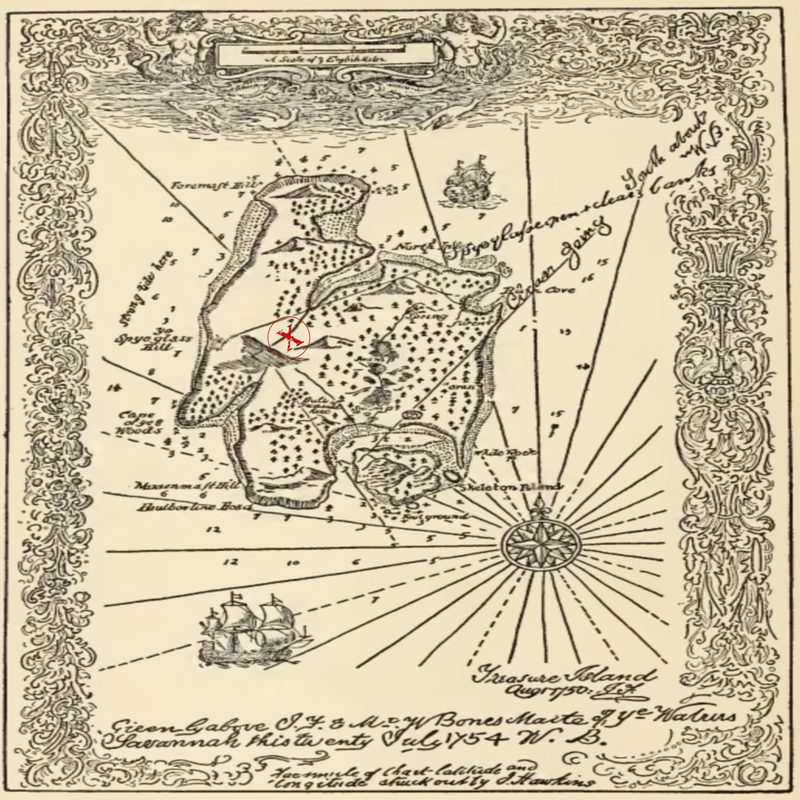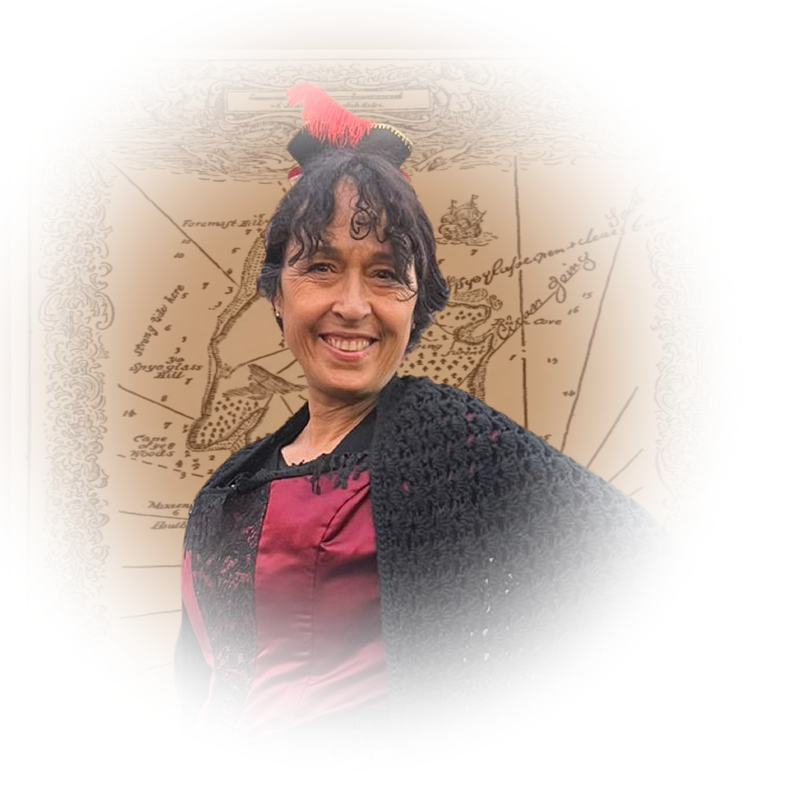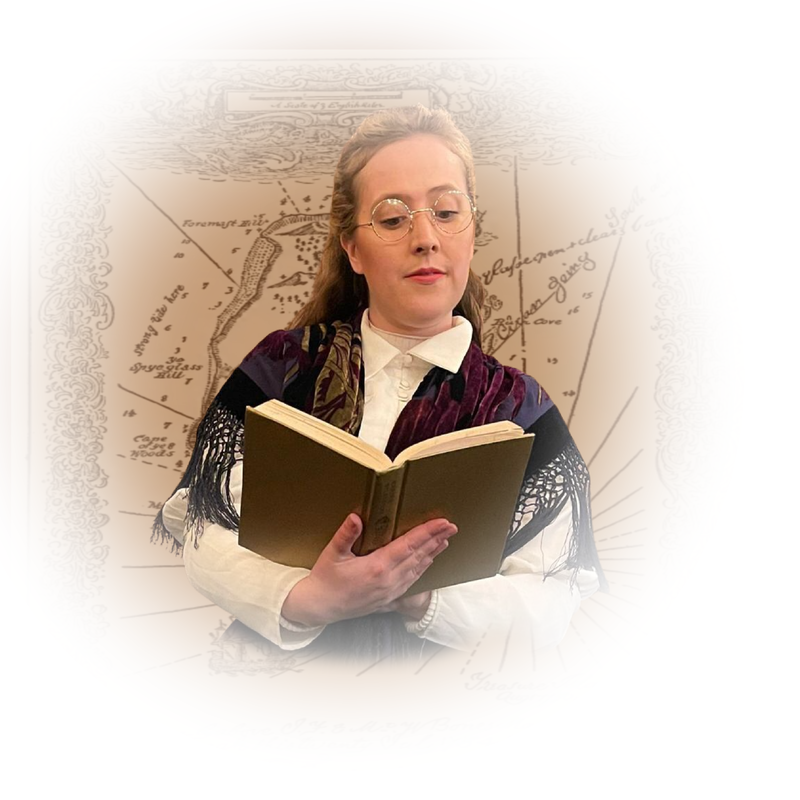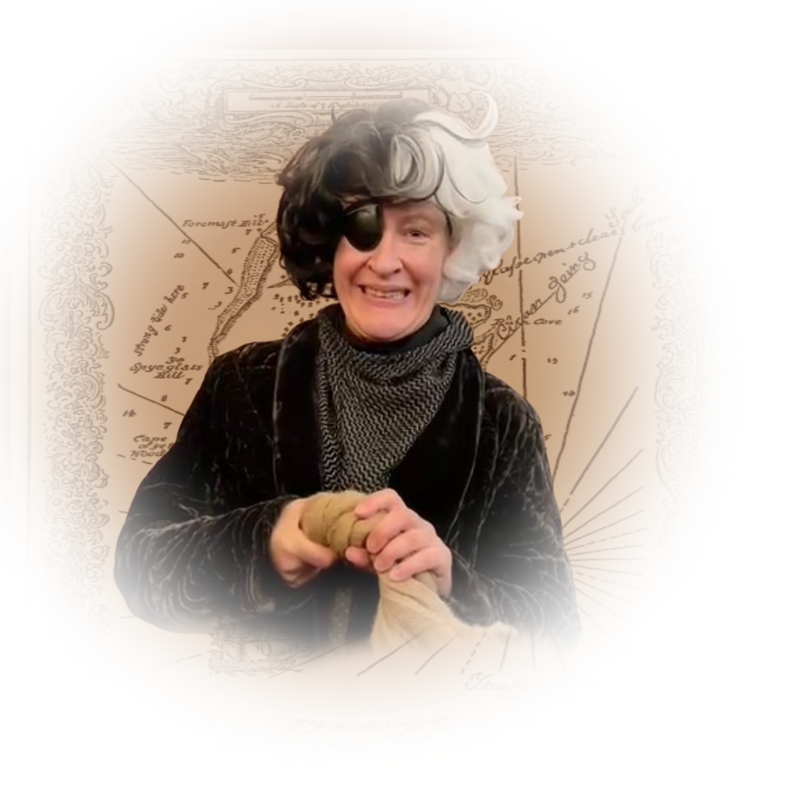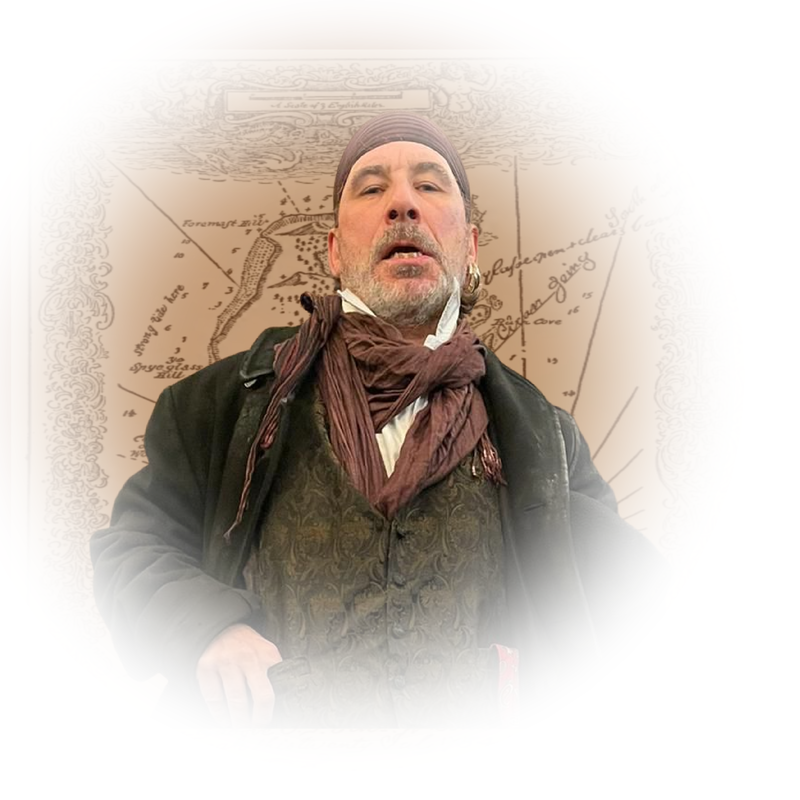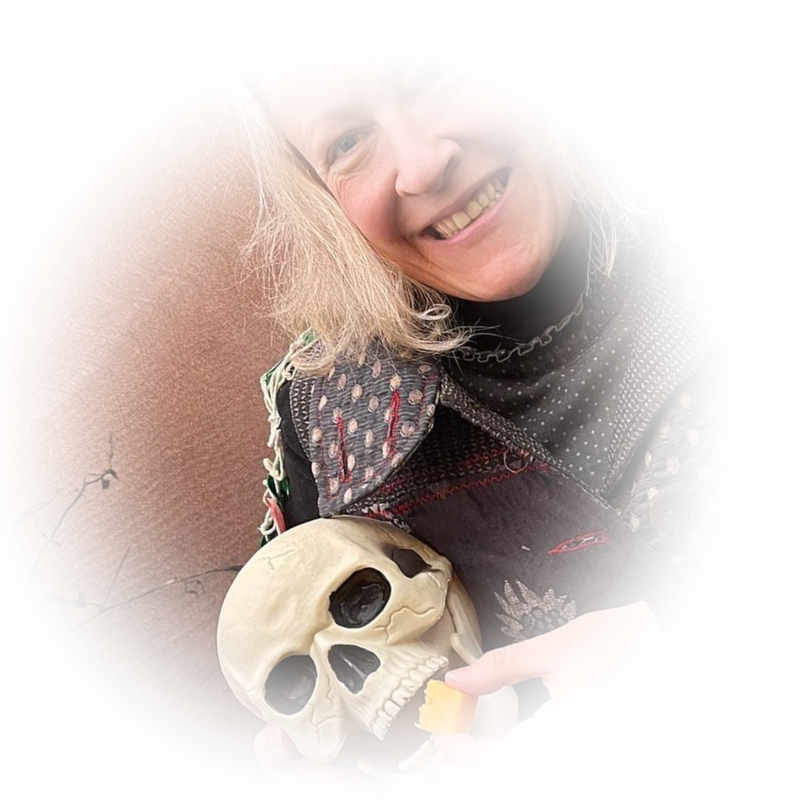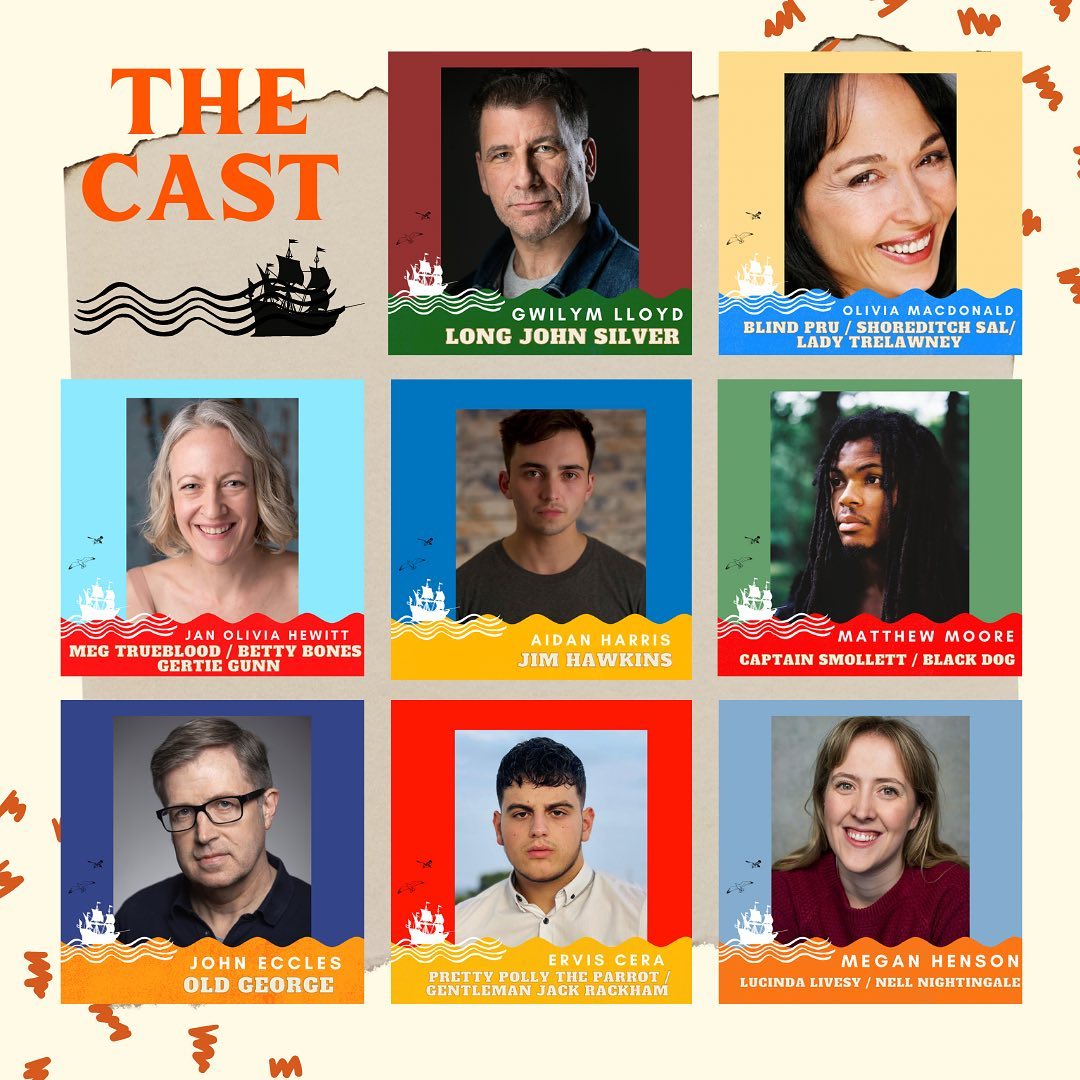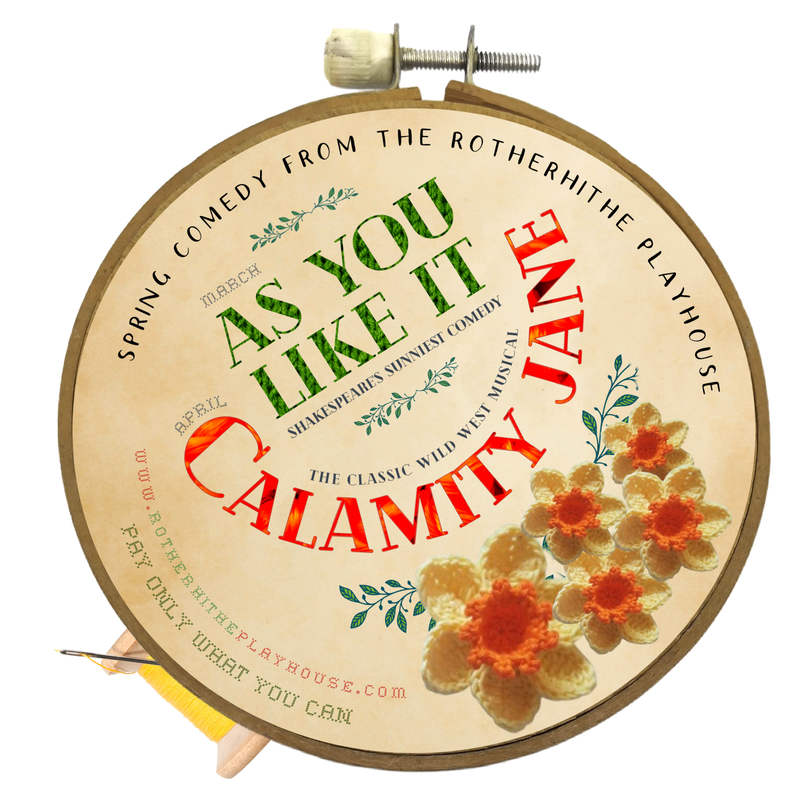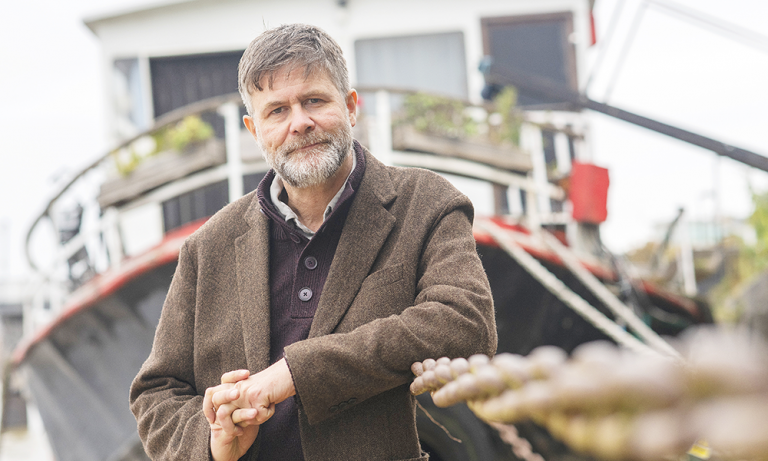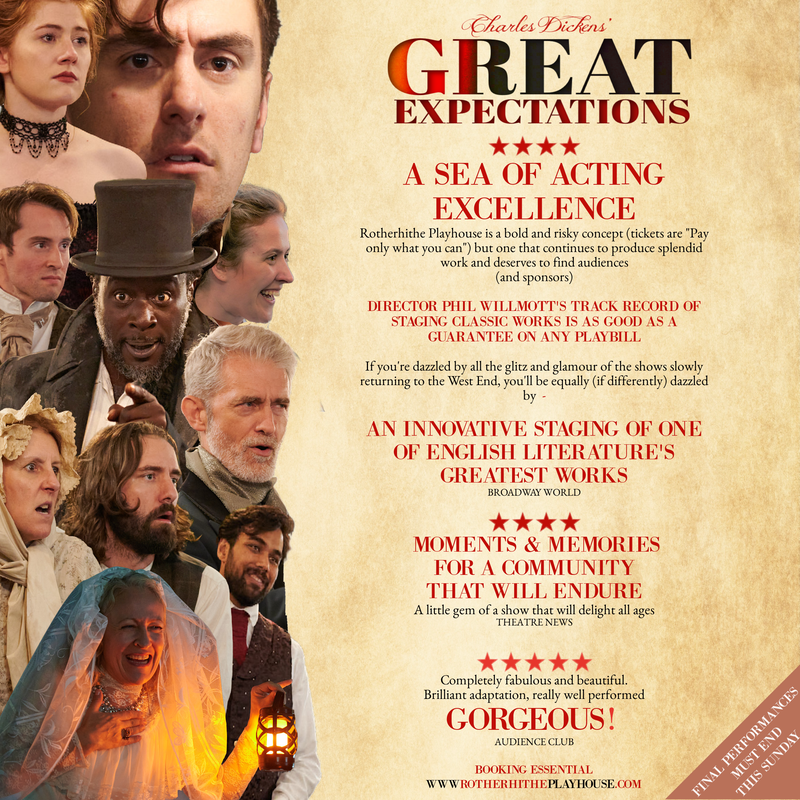BACK TO OUR HOME PAGE
HOW YOU CAN HELP | DONATE | TELL US WHAT YOU THOUGHT | ABOUT US | PREVIOUS PRODUCTIONS |
JOIN OUR MAILING LIST | CONTACT US | YOUR VISIT & COVID PRECAUTIONS
HOW YOU CAN HELP | DONATE | TELL US WHAT YOU THOUGHT | ABOUT US | PREVIOUS PRODUCTIONS |
JOIN OUR MAILING LIST | CONTACT US | YOUR VISIT & COVID PRECAUTIONS
TREASURE ISLAND
ON LINE PROGRAMME
ALL ABOUT THE STORY AND CHARACTERS
IN OUR VERSION OF TREASURE ISLAND
This is a story about Jim Hawkins.
When you meet him he has come to a very rough pub called the Admiral Benbow to try to find honest people to work aboard a ship which he and his friends have bought.
He tells pub customers about a terrible night when an old sailor lady, Betty Bones, was chased by someone know as Blind Pru to his mother's Inn, and about how Betty died leaving behind a map showing treasure on a distant Island.
When you meet him he has come to a very rough pub called the Admiral Benbow to try to find honest people to work aboard a ship which he and his friends have bought.
He tells pub customers about a terrible night when an old sailor lady, Betty Bones, was chased by someone know as Blind Pru to his mother's Inn, and about how Betty died leaving behind a map showing treasure on a distant Island.
Jim and his friends Lady Trelawny and Miss Livesey have decided to go in search of the treasure and now need sailors to help them on the voyage
With the help of the ship's skipper, Captain Smollet, the friends sign everyone in the pub up to join the crew including the grumpy sailor, Old George, and the pub's landlady Meg Trueblood... and you.
 Polly
Polly
Last but not least they sign up a one legged man named Long John Silver (and his Parrot, Polly) who will be the ship's cook.
Unfortunately no one realises that the new recruits are all... PIRATES!!!
On the voyage Jim becomes good friends with the cook. He seems to be a perfect father figure.
But when they arrive at Treasure Island and most of Jim's friends have left the ship to dig up the treasure he overhears the older man's dastardly plan.
He was only pretending to like Jim in order to get hold of the treasure map! Worse still when the landing party return he plans to kill them all and steal the treasure for himself!
The terrible man discovers Jim's hiding place and ties him to a barrel on deck.
Jim is rescued by a strange old lady called Gertie Gun who has been alone on the island for years and is craving cheese.
When his friends return from the island Gertie helps them dress up as a ghost and scare Long John Silver who surrenders at gun point.
On the voyage Jim becomes good friends with the cook. He seems to be a perfect father figure.
But when they arrive at Treasure Island and most of Jim's friends have left the ship to dig up the treasure he overhears the older man's dastardly plan.
He was only pretending to like Jim in order to get hold of the treasure map! Worse still when the landing party return he plans to kill them all and steal the treasure for himself!
The terrible man discovers Jim's hiding place and ties him to a barrel on deck.
Jim is rescued by a strange old lady called Gertie Gun who has been alone on the island for years and is craving cheese.
When his friends return from the island Gertie helps them dress up as a ghost and scare Long John Silver who surrenders at gun point.
Gertie dug up the Island's treasure long ago and is happy to share it with everyone in exchange for cheese.
Captain Smollet has been injured in the skirmish with Long John Silver and can no longer command the ship, so Jim is elected to be the new captain for the journey home.
Captain Smollet has been injured in the skirmish with Long John Silver and can no longer command the ship, so Jim is elected to be the new captain for the journey home.
ALL ABOUT PIRATES AND QUEENS AND HOW THE TREASURE CAME TO BE BURIED IN THE FIRST PLACE.
The story begins long before evets in our show with a dastardly band of pirates led by Captain Flint.
20 years before we meet them Flint led a team to a desert island to bury treasure (When the isle became known as TREASURE ISLAND)
Their leader ruthlessly murdered everyone there, so that only a treasure map could reveal the location of the buried riches, and sailed home with those crew members who had remained aboard.
Since that day Flint and all but four of the returnees have died and the survivors are obsessed with recovering the plunder.
In our version of Treasure Island Flint's gang are a collection of ferocious female pirates, the so called "Pirates and Queens" or "Ps and Qs" as they're now fearfully referred to.
20 years before we meet them Flint led a team to a desert island to bury treasure (When the isle became known as TREASURE ISLAND)
Their leader ruthlessly murdered everyone there, so that only a treasure map could reveal the location of the buried riches, and sailed home with those crew members who had remained aboard.
Since that day Flint and all but four of the returnees have died and the survivors are obsessed with recovering the plunder.
In our version of Treasure Island Flint's gang are a collection of ferocious female pirates, the so called "Pirates and Queens" or "Ps and Qs" as they're now fearfully referred to.
"Watch your Ps and Q's Lad, mind them Ps and Qs"
These pirates are based on both Robert Louis Stevenson's original characters and inspired by some of the real life women who once terrorised the Seven Seas.
For our purposes the group are led by Polly Flint and the surviving crew member are Betty Bones, Blind Pru, Gertie Gunn and the only male aboard their shi,p the former cabin boy, John Silver, now a grown up and the most terrifying of the lot. He has named his parrot Polly after his former captain.
"I didn't mean no disrespect but weren't she the most bad tempered bird, afore Jim tamed her"
These pirates are based on both Robert Louis Stevenson's original characters and inspired by some of the real life women who once terrorised the Seven Seas.
For our purposes the group are led by Polly Flint and the surviving crew member are Betty Bones, Blind Pru, Gertie Gunn and the only male aboard their shi,p the former cabin boy, John Silver, now a grown up and the most terrifying of the lot. He has named his parrot Polly after his former captain.
"I didn't mean no disrespect but weren't she the most bad tempered bird, afore Jim tamed her"
TWO OF HISTORY'S REAL LIFE Ps&Qs
When you think of pirates, you're likely picturing bearded buccaneers or peg-legged scalawags with names like Blackbeard, Barbarossa, and Calico Jack. While most pirates were men, there were women in these ranks of raiders who were just as merciless, notorious, and feared. Perhaps these two are the best known today but also check out Sadie the goat, Queen teuta of illyria, Back From the Dead Red, The Lioness Of Brittany, Anne Dieu-Le-Veut, Sayyida al Hurraand and Ching Shi.
Anne Bonny
Born Anne Cormac in 1698, this Irish lass with luscious red locks and a dangerous temper became an icon of The Golden Age of Piracy (1650s-1730s) after marrying small-time pirate James Bonny. Anne's respectable father disowned her over the marriage, so she and her new husband moved to a portion of the Bahamas nicknamed the Pirates Republic, a sanctuary of sorts for scalawags. But the Bonnys were not happily married for long.
They divorced, and she took up with Calico Jack Rackham, first as his lover, then as his first mate of the ship Revenge. In October of 1720, she and the rest of Rackham's crew were captured despite Bonny and her bosom buddy Mary Read's valiant attempts to fight off the advancing English forces. Bonny blamed Rackham for their capture. Her last words to him in prison are recorded as, "Sorry to see you there, but if you'd fought like a man, you would not have been hang'd like a Dog."
He was hanged, but Bonny's pregnancy earned her a stay of execution. However, no historical record of her death sentence was found. Some speculate that her affluent father paid a handsome price to have her set free.
Mary Read
Best mate of Anne Bonny was Mary Read, an Englishwoman born the bastard of a sea captain's widow. While Bonny was said to wear clothes that identified her as female, Read had a long history of masquerading as male that dates back to her youth. Her mother would dress Read as her late older brother to wheedle money from the dead boy's paternal grandmother. Years later, she joined the British military as Mark Read. She found love with a Flemish soldier, but upon his untimely death Read headed to the West Indies. As fate would have it, her ship was taken by pirates, who pushed her to join their ranks.
Cross-dressing as a man, Read set sail with Anne Bonny and Calico Jack on the Revenge in 1720. Some stories suggest that only Bonny and Jack knew of Read's womanhood, and only because the latter grew jealous when the former flirted with "Mark." Later that year, a third in their crew would learn Read's secret, and she claimed him as her husband.
When the Revenge was captured by pirate hunter Captain Jonathan Barnet, Read joined Bonny in "pleading the belly." But pregnancy from her unnamed husband would not save her. She died on April 28th 1721, from a violent fever in her prison cell. No record is made of the burial of a baby. Some suspect Read and the infant died during childbirth.
Anne Bonny
Born Anne Cormac in 1698, this Irish lass with luscious red locks and a dangerous temper became an icon of The Golden Age of Piracy (1650s-1730s) after marrying small-time pirate James Bonny. Anne's respectable father disowned her over the marriage, so she and her new husband moved to a portion of the Bahamas nicknamed the Pirates Republic, a sanctuary of sorts for scalawags. But the Bonnys were not happily married for long.
They divorced, and she took up with Calico Jack Rackham, first as his lover, then as his first mate of the ship Revenge. In October of 1720, she and the rest of Rackham's crew were captured despite Bonny and her bosom buddy Mary Read's valiant attempts to fight off the advancing English forces. Bonny blamed Rackham for their capture. Her last words to him in prison are recorded as, "Sorry to see you there, but if you'd fought like a man, you would not have been hang'd like a Dog."
He was hanged, but Bonny's pregnancy earned her a stay of execution. However, no historical record of her death sentence was found. Some speculate that her affluent father paid a handsome price to have her set free.
Mary Read
Best mate of Anne Bonny was Mary Read, an Englishwoman born the bastard of a sea captain's widow. While Bonny was said to wear clothes that identified her as female, Read had a long history of masquerading as male that dates back to her youth. Her mother would dress Read as her late older brother to wheedle money from the dead boy's paternal grandmother. Years later, she joined the British military as Mark Read. She found love with a Flemish soldier, but upon his untimely death Read headed to the West Indies. As fate would have it, her ship was taken by pirates, who pushed her to join their ranks.
Cross-dressing as a man, Read set sail with Anne Bonny and Calico Jack on the Revenge in 1720. Some stories suggest that only Bonny and Jack knew of Read's womanhood, and only because the latter grew jealous when the former flirted with "Mark." Later that year, a third in their crew would learn Read's secret, and she claimed him as her husband.
When the Revenge was captured by pirate hunter Captain Jonathan Barnet, Read joined Bonny in "pleading the belly." But pregnancy from her unnamed husband would not save her. She died on April 28th 1721, from a violent fever in her prison cell. No record is made of the burial of a baby. Some suspect Read and the infant died during childbirth.
ALL ABOUT ROBERT LOUIS BALFOUR STEVENSON (1850-1894)
A brief summary of the life Treasure Island's author.
An Imaginative Childhood (1850-1867)
Robert Louis Balfour Stevenson was born November 13, 1850 in Edinburgh, Scotland and was the only child of respectable middle-class parents. His father, Thomas, belonged to a family of engineers who had built most of the deep-sea lighthouses around the coast of Scotland. His mother, Margaret Isabella Balfour, came from a family of lawyers and church ministers.
Throughout his childhood, Stevenson suffered chronic health issues which confined him to his bed. These illnesses, frequently described as a “weak chest”, persisted throughout his life, taking the form of fevers, coughing, bronchial infections, and eventually the “Bluidy Jack”, a hemorrhaging of the lungs.
As a result of his persistent poor health, Stevenson had a limited formal education. Instead he was typically educated by private tutors and nannies, none so beloved as Allison Cunningham, whom he nicknamed “Cummy.” Cummy would regularly read to him from the Old Testament, Catechisms, and Bunyan’s Pilgrim Progress. This somewhat isolated childhood led to the development of a healthy imagination through which dreams of being a writer developed.
Becoming a Writer (1867-1876)
In 1867, Stevenson entered the University of Edinburgh as a science student where it was understood he would follow in the family tradition to become a civil engineer and join the family building firm. However, Stevenson was disinterested in the courses and turned his attention to French literature, Scottish history, and the revolutionary works of Charles Darwin and Herbert Spencer.
In addition to a diversion in his studies, he also began to develop a more bohemian appearance, growing his hair long and wearing a velvet jacket when about town. He also developed more atheist beliefs, diverging from those of his parents, and began spending more time in the lounge of the Speculative Society – a group for orators and writers at the university.
When Stevenson finally confided to his father that he did not want to become an engineer and instead wanted to pursue writing, his father was, understandably, upset. They eventually agreed that a professional degree was needed and so Louis would study law.
During summer holidays, Louis would go to France to be in the company of other young artists, writers, and painters. There he worked on essays and, upon returning to Europe, spent much of his time writing book reviews and articles while experimenting with short stories. His first published work, an essay called Roads, and his first published volumes were works of travel writing.
In 1875, Louis left university having “passed advocate” and earning a law degree. Never planning to practice law however, he continued to write – always keeping two books with him “one to read, and one to write in.”
On Falling In Love (1876 - 1880)
Seeking an adventure to inspire his writing, Stevenson embarked on a canoe trip from Antwerp, Belgium, to northern France with his friend, Walter Simpson. This trip would later inspire his work An Inland Voyage.
In September 1876 Stevenson found his way to the small artist town of Grez-sur-Loing, outside Paris, to meet with his cousin Robert “Bob” Alan Mowbray Stevenson.
Unexpectedly, it was here that Louis was introduced to a married American woman, Fanny Osbourne, and her two children, Belle and Lloyd. At the time, Louis was twenty-five and Fanny, thirty-six. Despite this age difference, Louis fell in love with the intelligent and independent American “new woman” who was separated from her philandering husband.
For two years, their relationship bloomed until Fanny was forced to return to California and her husband. Having lost Fanny, Louis took his broken heart to the south of France for a walking tour. This journey would inspire his work Travels with a Donkey in the Cevennes.
A year later word came from Fanny that inspired Stevenson to travel to America in pursuit of his love. A steamer from Glasgow brought him to New York. He then traveled by rail and carriage until arriving in California. His arduous journey west would later inspired his work, The Amateur Emigrant. Reunited with Fanny after some time, Fanny received her divorce from her husband in December 1879 and in May 1880 the two were married in San Francisco.
The following months were spent in Napa Valley where Louis would pen his next work The Silverado Squatters.
Fame and Adventure (1880 - 1894)
In August 1880 the Stevensons returned to England. Stevenson and his wife had wintered in the South of France and lived in England from 1880-1887, a period of time marked by Stevenson’s poor health and literary achievements. His first novel, Treasure Island, was published in 1883, followed by A Child’s Garden of Verses (1886), Strange Case of Dr. Jekyll and Mr. Hyde (1886), and Kidnapped (1886). Stevenson’s work was widely popular and received great critical acclaim.
Upon his father’s death in 1887, Stevenson and his family left England for America where he stayed for one year. In June 1888, accompanied by Fanny, Lloyd, and Margaret, he set sail for the South Seas.
Enchanted with life in the South Seas and convinced he could not endure another winter in Scotland, in January of 1890 Stevenson purchased an estate in Apia, Samoa. The climate of the tropics did wonders for Stevenson’s health and the regular postal service meant he could continue regular correspondence with his publishers
.
Stevenson lived on his estate, Vailima, in the hills of Apia until his death at age 44 in 1894. While at Vailima, Stevenson wrote a great deal completing two of his finest novellas, The Beach of Falesa and the Ebb Tide (written with Lloyd) as well as two novels, The Wrecker and Catriona (aka David Balfour). He also completed the short stories, The Bottle Imp and The Isle of Voices.
On December 3, 1894. Louis seemed in excellent spirits when he suddenly collapsed from a violent pain in his head and he lost consciousness. Stevenson, having suffered a brain hemorrhage and died soon afterwards. He was interred the following morning at the top of Mount Vaea.
An Imaginative Childhood (1850-1867)
Robert Louis Balfour Stevenson was born November 13, 1850 in Edinburgh, Scotland and was the only child of respectable middle-class parents. His father, Thomas, belonged to a family of engineers who had built most of the deep-sea lighthouses around the coast of Scotland. His mother, Margaret Isabella Balfour, came from a family of lawyers and church ministers.
Throughout his childhood, Stevenson suffered chronic health issues which confined him to his bed. These illnesses, frequently described as a “weak chest”, persisted throughout his life, taking the form of fevers, coughing, bronchial infections, and eventually the “Bluidy Jack”, a hemorrhaging of the lungs.
As a result of his persistent poor health, Stevenson had a limited formal education. Instead he was typically educated by private tutors and nannies, none so beloved as Allison Cunningham, whom he nicknamed “Cummy.” Cummy would regularly read to him from the Old Testament, Catechisms, and Bunyan’s Pilgrim Progress. This somewhat isolated childhood led to the development of a healthy imagination through which dreams of being a writer developed.
Becoming a Writer (1867-1876)
In 1867, Stevenson entered the University of Edinburgh as a science student where it was understood he would follow in the family tradition to become a civil engineer and join the family building firm. However, Stevenson was disinterested in the courses and turned his attention to French literature, Scottish history, and the revolutionary works of Charles Darwin and Herbert Spencer.
In addition to a diversion in his studies, he also began to develop a more bohemian appearance, growing his hair long and wearing a velvet jacket when about town. He also developed more atheist beliefs, diverging from those of his parents, and began spending more time in the lounge of the Speculative Society – a group for orators and writers at the university.
When Stevenson finally confided to his father that he did not want to become an engineer and instead wanted to pursue writing, his father was, understandably, upset. They eventually agreed that a professional degree was needed and so Louis would study law.
During summer holidays, Louis would go to France to be in the company of other young artists, writers, and painters. There he worked on essays and, upon returning to Europe, spent much of his time writing book reviews and articles while experimenting with short stories. His first published work, an essay called Roads, and his first published volumes were works of travel writing.
In 1875, Louis left university having “passed advocate” and earning a law degree. Never planning to practice law however, he continued to write – always keeping two books with him “one to read, and one to write in.”
On Falling In Love (1876 - 1880)
Seeking an adventure to inspire his writing, Stevenson embarked on a canoe trip from Antwerp, Belgium, to northern France with his friend, Walter Simpson. This trip would later inspire his work An Inland Voyage.
In September 1876 Stevenson found his way to the small artist town of Grez-sur-Loing, outside Paris, to meet with his cousin Robert “Bob” Alan Mowbray Stevenson.
Unexpectedly, it was here that Louis was introduced to a married American woman, Fanny Osbourne, and her two children, Belle and Lloyd. At the time, Louis was twenty-five and Fanny, thirty-six. Despite this age difference, Louis fell in love with the intelligent and independent American “new woman” who was separated from her philandering husband.
For two years, their relationship bloomed until Fanny was forced to return to California and her husband. Having lost Fanny, Louis took his broken heart to the south of France for a walking tour. This journey would inspire his work Travels with a Donkey in the Cevennes.
A year later word came from Fanny that inspired Stevenson to travel to America in pursuit of his love. A steamer from Glasgow brought him to New York. He then traveled by rail and carriage until arriving in California. His arduous journey west would later inspired his work, The Amateur Emigrant. Reunited with Fanny after some time, Fanny received her divorce from her husband in December 1879 and in May 1880 the two were married in San Francisco.
The following months were spent in Napa Valley where Louis would pen his next work The Silverado Squatters.
Fame and Adventure (1880 - 1894)
In August 1880 the Stevensons returned to England. Stevenson and his wife had wintered in the South of France and lived in England from 1880-1887, a period of time marked by Stevenson’s poor health and literary achievements. His first novel, Treasure Island, was published in 1883, followed by A Child’s Garden of Verses (1886), Strange Case of Dr. Jekyll and Mr. Hyde (1886), and Kidnapped (1886). Stevenson’s work was widely popular and received great critical acclaim.
Upon his father’s death in 1887, Stevenson and his family left England for America where he stayed for one year. In June 1888, accompanied by Fanny, Lloyd, and Margaret, he set sail for the South Seas.
Enchanted with life in the South Seas and convinced he could not endure another winter in Scotland, in January of 1890 Stevenson purchased an estate in Apia, Samoa. The climate of the tropics did wonders for Stevenson’s health and the regular postal service meant he could continue regular correspondence with his publishers
.
Stevenson lived on his estate, Vailima, in the hills of Apia until his death at age 44 in 1894. While at Vailima, Stevenson wrote a great deal completing two of his finest novellas, The Beach of Falesa and the Ebb Tide (written with Lloyd) as well as two novels, The Wrecker and Catriona (aka David Balfour). He also completed the short stories, The Bottle Imp and The Isle of Voices.
On December 3, 1894. Louis seemed in excellent spirits when he suddenly collapsed from a violent pain in his head and he lost consciousness. Stevenson, having suffered a brain hemorrhage and died soon afterwards. He was interred the following morning at the top of Mount Vaea.
Fun facts about RLS
1. We’ve been mispronouncing his middle name all this time. Stevenson – or ‘RLS’ as he is sometimes known – was born Robert Lewis Balfour Stevenson, in 1850. He later changed ‘Lewis’ to ‘Louis’, but continued to pronounce it ‘Lewis’. He also dropped the ‘Balfour’ middle name, although he would later use it as the surname for David Balfour, the protagonist of Stevenson’s adventure novel, Kidnapped (1886).
2. He was something of a literary superstar. Stevenson sometimes bemoaned the sensationalist way in which publishers promoted his work to the public: his 1884 Christmas story, ‘The Body Snatcher’, had been advertised by six men who had been paid to roam the streets wearing huge coffin-shaped sandwich boards and plaster skulls (these Robert Louis Stevenson figures caused such a stir among the people of London that the police were called in to ‘suppress the nuisance’ … the power of advertising!). His first novel, Treasure Island, even helped to inspire another of the great Victorian adventure novels of the 1880s. (Treasure Island would also invent many of the classic tropes we associate with pirates.)
3. He gifted his birthday to someone. While he was living in the South Seas – where he would die in 1894 – Stevenson discovered that the 12-year-old daughter of Henry Clay Ide, the US Commissioner to Samoa, had her birthday on Christmas Day and disliked this. All her friends had a birthday and Christmas Day (and so two lots of presents!), whereas she had to make do with one special day each year. Stevenson nobly signed away all ‘rights’ to his birthday to the girl, as a letter of 1891 makes clear: ‘I … Have transferred, and do hereby transfer to the said A. H. Ide, All and Whole of my rights and privileges in the 13th day of November, formerly my birthday, now, hereby, and henceforth, the birthday of the said A. H. Ide, to have, hold, exercise and enjoy the same in the customary manner, by the sporting of fine raiment, eating of rich meats and receipt of gifts, compliments and copies of verse, according to the manner of our ancestors.’ What a nice man!
4. According to his stepson, he destroyed the first draft of Jekyll and Hyde and rewrote it from scratch. The idea for the story of Strange Case of Dr Jekyll and Mr Hyde (1886) came to Stevenson in a dream. His wife criticised the initial manuscript, which was produced in just three days, and it has been suggested that Stevenson burnt the manuscript following this adverse verdict from his beloved wife, and her suggestion that he had ‘missed the allegory’ of the story he was writing. However, we must be wary of taking this story at face value, since it has become part of the mythology surrounding the creation of the novel, and was told, at any rate, by Stevenson’s stepson, Lloyd Osbourne, who was not a reliable storyteller by any means. At any rate, Stevenson rewrote the tale after that, again very rapidly (it appears to have taken him about six weeks this time), and it was sent off for publication soon after. The rest, as they clichaically say, is history. Though much of what we think we know about the book – including how to pronounce ‘Jekyll’ – is shrouded in the sort of thick mist that hangs over the dark London streets in the novella itself.
2. He was something of a literary superstar. Stevenson sometimes bemoaned the sensationalist way in which publishers promoted his work to the public: his 1884 Christmas story, ‘The Body Snatcher’, had been advertised by six men who had been paid to roam the streets wearing huge coffin-shaped sandwich boards and plaster skulls (these Robert Louis Stevenson figures caused such a stir among the people of London that the police were called in to ‘suppress the nuisance’ … the power of advertising!). His first novel, Treasure Island, even helped to inspire another of the great Victorian adventure novels of the 1880s. (Treasure Island would also invent many of the classic tropes we associate with pirates.)
3. He gifted his birthday to someone. While he was living in the South Seas – where he would die in 1894 – Stevenson discovered that the 12-year-old daughter of Henry Clay Ide, the US Commissioner to Samoa, had her birthday on Christmas Day and disliked this. All her friends had a birthday and Christmas Day (and so two lots of presents!), whereas she had to make do with one special day each year. Stevenson nobly signed away all ‘rights’ to his birthday to the girl, as a letter of 1891 makes clear: ‘I … Have transferred, and do hereby transfer to the said A. H. Ide, All and Whole of my rights and privileges in the 13th day of November, formerly my birthday, now, hereby, and henceforth, the birthday of the said A. H. Ide, to have, hold, exercise and enjoy the same in the customary manner, by the sporting of fine raiment, eating of rich meats and receipt of gifts, compliments and copies of verse, according to the manner of our ancestors.’ What a nice man!
4. According to his stepson, he destroyed the first draft of Jekyll and Hyde and rewrote it from scratch. The idea for the story of Strange Case of Dr Jekyll and Mr Hyde (1886) came to Stevenson in a dream. His wife criticised the initial manuscript, which was produced in just three days, and it has been suggested that Stevenson burnt the manuscript following this adverse verdict from his beloved wife, and her suggestion that he had ‘missed the allegory’ of the story he was writing. However, we must be wary of taking this story at face value, since it has become part of the mythology surrounding the creation of the novel, and was told, at any rate, by Stevenson’s stepson, Lloyd Osbourne, who was not a reliable storyteller by any means. At any rate, Stevenson rewrote the tale after that, again very rapidly (it appears to have taken him about six weeks this time), and it was sent off for publication soon after. The rest, as they clichaically say, is history. Though much of what we think we know about the book – including how to pronounce ‘Jekyll’ – is shrouded in the sort of thick mist that hangs over the dark London streets in the novella itself.
OUR TREASURE FOR EVER PROJECT.
Why not take part in our TREASURE FOREVER programme?
We want to give every pirate prince and princess who comes to see Treasure Island a copy of Robert Louis Stevenson's classic novel; to take away with them and keep, encouraging reading as a life-long pleasure.
But we need your help. Simply click our Amazon Wish List to donate (£2.25 inc. P&P) and they'll send us a brand new edition of the masterpiece to pass on to the youngsters encountering the tale of Jim Hawkins and Long John Silver, for the first time or afresh, at Rotherhithe Playhouse.
Keep an eye on our website for other classic novels we bring to the stage. We're nuts about reading and we want to, quite literally, spread the word.
We want to give every pirate prince and princess who comes to see Treasure Island a copy of Robert Louis Stevenson's classic novel; to take away with them and keep, encouraging reading as a life-long pleasure.
But we need your help. Simply click our Amazon Wish List to donate (£2.25 inc. P&P) and they'll send us a brand new edition of the masterpiece to pass on to the youngsters encountering the tale of Jim Hawkins and Long John Silver, for the first time or afresh, at Rotherhithe Playhouse.
Keep an eye on our website for other classic novels we bring to the stage. We're nuts about reading and we want to, quite literally, spread the word.
THE TREASURSE ISLAND CAST
See The Rotherhithe Playhouse Facebook Page for Full Biographies
COMING NEXT - BOOKING OPENS FEBRUARY 1ST 2022
AN INTERVIEW WITH ROTHERHITHE PLAYHOUSE' ARTISTIC DIRECTOR PHIL WILLMOTT
Reproduced by kind permission of WHARF LIFE
Phil Willmott of Rotherhithe Playhouse – image Matt Grayson
Subscribe to Wharf Life’s weekly newsletter here
BY LAURA ENFIELD
When life fell apart, Phil Willmott found himself broke and bored.
The Rotherhithe resident went from being one of the most commissioned theatre writers in the UK as well as a director, artistic director, composer, librettist, teacher, arts journalist and actor to, well, a man sat in a room.
As he has done since childhood, the 55-year-old turned to theatre, launching Rotherhithe Playhouse just after the first lockdown.
It started with Hamlet on the riverside and progressed to A Christmas Carol, the Rotherhithe Gospels and Great Expectations, each performed in a different open air location with sets built from recycled and found materials.
Current production The Macbeths runs until November 6 in the courtyard of The Ship in Rotherhithe
We sat down to find out more about the man behind the company.
How did Rotherhithe Playhouse start?
As a kid, theatre was really important to me. I didn’t go to a particularly good school so I would take myself off on Saturday afternoons to see plays and musicals at Bristol Old Vic.
It was how I learnt about the world. When Covid closed all the theatres, I realised there was a real danger of a whole generation of kids never being taken to the theatre, who will have never seen the plays they are studying.
I felt the longer the pandemic went on, the more people would get out of the habit of going to the theatre, so an entire art form could die away.
There is a beautiful riverfront outside my window so I thought I would get some actors together and we would go and do Hamlet down there.
It was very simply staged and the audience was really transported by it. I just thought we had to keep it going.
What makes it different from a conventional theatre?
Each production is in a different venue in Rotherhithe to help bring them to a wider public. I don’t think I would be interested in the nuts and bolts of running a permanent venue but each month we build a new theatre from scratch – it’s very exciting and you can adapt the performance to the site you are in and make it very special.
Tickets are free if you access food banks or subsidised school meals and for everyone else we run the Pay What You Can scheme. That way I hope it will always be affordable for people to take their kids to see a magnificent piece of literature, which is really life enhancing.
The other innovative thing we do is with the creatives. Because of the pandemic, lots of them took proper full-time jobs and now they find it impossible to give them up for short-term theatre commitments. So we only work outside of office hours so they can participate.
What sparked your interest in theatre?
Pantomime. I was taken as an annual treat and I used to sit there intently watching it so that for months, as I fell asleep, I could run it in my mind.
I came from quite a working class background in Bristol so there was no-one to explain theatre to me. I assumed it was just the actors. It didn’t occur to me that someone wrote and directed and designed it.
I thought I wanted to be an actor and trained for three years and was relatively successful playing, ironically, upper class twits in light entertainment and ended up in a Science Fiction soap opera Jupiter Moon that they used to launch Sky.
It was a fantastic cast with people like Anna Chancellor and Jamie Glover. I have never laughed so much and made lifelong friends. But after that, I realised acting wasn’t for me.
I started writing plays and sent one in a brown envelope literally addressed to The BBC, London and a fantastic producer picked it up and they did it on Radio 4. One day I wanted someone to direct a version of it and I decided to have a go myself. Ever since I have had this three-pronged career.
I prefer theatre, as being on TV is more like being in a factory. Theatre is a knife edge and I still feel that now times ten because every day is fighting fires. I just wish I could make a living at it on its own.
How did lockdown affect you?
It was truly shocking and even now I’m struggling to acclimatise. I hadn’t been unemployed for 30 years. Suddenly it all stopped and, from an incredibly busy, stressful life there was just me, sat in a room. I was forced to say: “I’m not my career. Who am I? What do I believe in? What do I want to happen?”.
I discovered I had to make theatre because it was in my blood but I had to find a new way of doing it for life, during and after this wretched pandemic.
Before, I was glued to my diary and didn’t know who I was. Now, ironically, because of this project, I’m still a person rushing around putting on plays but I know why. It was a chance to throw it all up in the air and decide what I wanted to take from my old life into my new life.
Also, for the first time in my life, I became penniless. I wasn’t wealthy before but never in my life, even as a student, had I had to stop and think: “Can I afford a coffee?”
.
That was very sobering and fuelled me to think about how I could help other people in this situation. There are many wonderful people running food banks but I think as humans we have to be a bit more than that.
Why did you choose to perform classics?
I always assume people will be sick of things like Macbeth or Great Expectations and know them inside and backwards.
But people come who have no idea of the story and who have never heard them and it’s so exciting to give people their first experience of these incredible pieces of work.
Shakespeare is this miraculous, ridiculous phenomenon because there are these words and every time you go back to them they mean something different. It’s endlessly rich and rewarding.
Have you discovered any parallels between your latest production and your present situation?
Completely. Macbeth starts off with a very certain trajectory and then everything falls apart and it comes from an unexpected quarter, his encounter with the three witches, which feels a bit like our encounter with this strange disease which came out of nowhere.
He’s ruthless and violent and I’m not those things but we were all brought up to think about career and how we advance and get a better job.
Then, suddenly that rug is pulled away and we are in the situation that Macbeth is in. What does he pursue and what feels wrong? Of course he makes all the wrong choices, but watching him do that tells us a lot about our lives and our choices.
Are you happy with your choices?
I’m making the best choices I can and struggling every day to do it better. When we started, nobody showed up and now it has a little fanbase, so I’m sure there is a need for it. But it is endlessly exhausting not having any money.
Everything has to be found on the street or bought in the pound shop. There’s no way it can make money, unless it’s very heavily subsidised, because the pop-up theatres we make seat a maximum of 60 people.
I haven’t taken another job so far, but will have to change that because it’s impossible to keep living on £20 a week. I just know we have to always be there for our community. So, no matter what, they can go to the theatre and see something fantastic.
How has the community responded?
It’s very difficult to get places to perform. I’m quite cross with some people who won’t let me put our theatre up in their forecourt. It’s troubling and has been a bit of an eye-opener.
Organisations that you think would go out of their way to help you find all sorts of by-laws and nonsense in order to justify saying no. But we are winning people over.
We need about 5m by 9m for our marquee and, if you give us that, we will create something magical for your part of the community. We don’t even need your electricity supply as we run everything on batteries.
What other help do you need?
We had a fantastic general manager, who has now moved on, so I’m looking. I feel there might be recent retirees out there who’d like to learn to project manage one show a year.
My absolute dream would be just to worry about what happened on stage. Also, if anyone has any money and would like to sponsor us, they would be contributing to something wonderful
.
Will you perform any new plays?
I only want people who come to see masterpieces – nothing second rate because a bad theatre experience can mean you don’t go for the next 10 years.
I might write something about Doctor Salter and his wife who have statues on the riverbank because not many people know about them. They really suffered for what they believed but stayed and improved the area for everyone.
BY LAURA ENFIELD
When life fell apart, Phil Willmott found himself broke and bored.
The Rotherhithe resident went from being one of the most commissioned theatre writers in the UK as well as a director, artistic director, composer, librettist, teacher, arts journalist and actor to, well, a man sat in a room.
As he has done since childhood, the 55-year-old turned to theatre, launching Rotherhithe Playhouse just after the first lockdown.
It started with Hamlet on the riverside and progressed to A Christmas Carol, the Rotherhithe Gospels and Great Expectations, each performed in a different open air location with sets built from recycled and found materials.
Current production The Macbeths runs until November 6 in the courtyard of The Ship in Rotherhithe
We sat down to find out more about the man behind the company.
How did Rotherhithe Playhouse start?
As a kid, theatre was really important to me. I didn’t go to a particularly good school so I would take myself off on Saturday afternoons to see plays and musicals at Bristol Old Vic.
It was how I learnt about the world. When Covid closed all the theatres, I realised there was a real danger of a whole generation of kids never being taken to the theatre, who will have never seen the plays they are studying.
I felt the longer the pandemic went on, the more people would get out of the habit of going to the theatre, so an entire art form could die away.
There is a beautiful riverfront outside my window so I thought I would get some actors together and we would go and do Hamlet down there.
It was very simply staged and the audience was really transported by it. I just thought we had to keep it going.
What makes it different from a conventional theatre?
Each production is in a different venue in Rotherhithe to help bring them to a wider public. I don’t think I would be interested in the nuts and bolts of running a permanent venue but each month we build a new theatre from scratch – it’s very exciting and you can adapt the performance to the site you are in and make it very special.
Tickets are free if you access food banks or subsidised school meals and for everyone else we run the Pay What You Can scheme. That way I hope it will always be affordable for people to take their kids to see a magnificent piece of literature, which is really life enhancing.
The other innovative thing we do is with the creatives. Because of the pandemic, lots of them took proper full-time jobs and now they find it impossible to give them up for short-term theatre commitments. So we only work outside of office hours so they can participate.
What sparked your interest in theatre?
Pantomime. I was taken as an annual treat and I used to sit there intently watching it so that for months, as I fell asleep, I could run it in my mind.
I came from quite a working class background in Bristol so there was no-one to explain theatre to me. I assumed it was just the actors. It didn’t occur to me that someone wrote and directed and designed it.
I thought I wanted to be an actor and trained for three years and was relatively successful playing, ironically, upper class twits in light entertainment and ended up in a Science Fiction soap opera Jupiter Moon that they used to launch Sky.
It was a fantastic cast with people like Anna Chancellor and Jamie Glover. I have never laughed so much and made lifelong friends. But after that, I realised acting wasn’t for me.
I started writing plays and sent one in a brown envelope literally addressed to The BBC, London and a fantastic producer picked it up and they did it on Radio 4. One day I wanted someone to direct a version of it and I decided to have a go myself. Ever since I have had this three-pronged career.
I prefer theatre, as being on TV is more like being in a factory. Theatre is a knife edge and I still feel that now times ten because every day is fighting fires. I just wish I could make a living at it on its own.
How did lockdown affect you?
It was truly shocking and even now I’m struggling to acclimatise. I hadn’t been unemployed for 30 years. Suddenly it all stopped and, from an incredibly busy, stressful life there was just me, sat in a room. I was forced to say: “I’m not my career. Who am I? What do I believe in? What do I want to happen?”.
I discovered I had to make theatre because it was in my blood but I had to find a new way of doing it for life, during and after this wretched pandemic.
Before, I was glued to my diary and didn’t know who I was. Now, ironically, because of this project, I’m still a person rushing around putting on plays but I know why. It was a chance to throw it all up in the air and decide what I wanted to take from my old life into my new life.
Also, for the first time in my life, I became penniless. I wasn’t wealthy before but never in my life, even as a student, had I had to stop and think: “Can I afford a coffee?”
.
That was very sobering and fuelled me to think about how I could help other people in this situation. There are many wonderful people running food banks but I think as humans we have to be a bit more than that.
Why did you choose to perform classics?
I always assume people will be sick of things like Macbeth or Great Expectations and know them inside and backwards.
But people come who have no idea of the story and who have never heard them and it’s so exciting to give people their first experience of these incredible pieces of work.
Shakespeare is this miraculous, ridiculous phenomenon because there are these words and every time you go back to them they mean something different. It’s endlessly rich and rewarding.
Have you discovered any parallels between your latest production and your present situation?
Completely. Macbeth starts off with a very certain trajectory and then everything falls apart and it comes from an unexpected quarter, his encounter with the three witches, which feels a bit like our encounter with this strange disease which came out of nowhere.
He’s ruthless and violent and I’m not those things but we were all brought up to think about career and how we advance and get a better job.
Then, suddenly that rug is pulled away and we are in the situation that Macbeth is in. What does he pursue and what feels wrong? Of course he makes all the wrong choices, but watching him do that tells us a lot about our lives and our choices.
Are you happy with your choices?
I’m making the best choices I can and struggling every day to do it better. When we started, nobody showed up and now it has a little fanbase, so I’m sure there is a need for it. But it is endlessly exhausting not having any money.
Everything has to be found on the street or bought in the pound shop. There’s no way it can make money, unless it’s very heavily subsidised, because the pop-up theatres we make seat a maximum of 60 people.
I haven’t taken another job so far, but will have to change that because it’s impossible to keep living on £20 a week. I just know we have to always be there for our community. So, no matter what, they can go to the theatre and see something fantastic.
How has the community responded?
It’s very difficult to get places to perform. I’m quite cross with some people who won’t let me put our theatre up in their forecourt. It’s troubling and has been a bit of an eye-opener.
Organisations that you think would go out of their way to help you find all sorts of by-laws and nonsense in order to justify saying no. But we are winning people over.
We need about 5m by 9m for our marquee and, if you give us that, we will create something magical for your part of the community. We don’t even need your electricity supply as we run everything on batteries.
What other help do you need?
We had a fantastic general manager, who has now moved on, so I’m looking. I feel there might be recent retirees out there who’d like to learn to project manage one show a year.
My absolute dream would be just to worry about what happened on stage. Also, if anyone has any money and would like to sponsor us, they would be contributing to something wonderful
.
Will you perform any new plays?
I only want people who come to see masterpieces – nothing second rate because a bad theatre experience can mean you don’t go for the next 10 years.
I might write something about Doctor Salter and his wife who have statues on the riverbank because not many people know about them. They really suffered for what they believed but stayed and improved the area for everyone.




